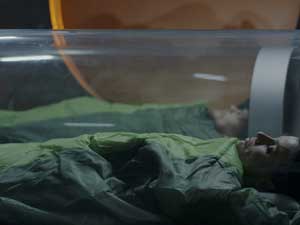| Dec 05, 2019 |
Could hibernating astronauts make it easier to reach other planets?
|
|
(Nanowerk News) Space travellers sleeping in hibernation chambers before continuing with their missions, whether to go on a trip to Jupiter or hunt down an extraterrestrial creature. The concept was first imagined in the 20th century before making its way to the big screen. Are these images getting hauntingly prophetic?
|
|
For future missions to succeed, radical changes will be needed in the way astronauts operate in space. According to a study by the European Space Agency (ESA), putting astronauts into a state of suspended animation may be the way to go.
|
 |
|
A team of researchers investigated how hibernation would influence the design of a crewed mission to Mars. Findings show that it would be very beneficial to build smaller spacecraft. By removing the crew’s living space that’s no longer needed and lessening supplies, the team conceived a design that decreases the spacecraft’s mass by a third.
|
|
“We worked on adjusting the architecture of the spacecraft, its logistics, protection against radiation, power consumption and overall mission design,” said Robin Biesbroek of ESA’s Concurrent Design Facility (CDF), a state-of-the-art centre that enables specialist teams to carry out initial assessments of proposed future missions. CDF’s goal is to evaluate the advantages of human hibernation for a trip to a planet like Mars.
|
Space snooze fest
|
|
“We looked at how an astronaut team could be best put into hibernation, what to do in case of emergencies, how to handle human safety and even what impact hibernation would have on the psychology of the team,” noted Biesbroek. “Finally we created an initial sketch of the habitat architecture and created a roadmap to achieve a validated approach to hibernate humans to Mars within 20 years.”
|
|
The idea of slowing down humans’ metabolic rate in the same way that animals hibernate is nowhere near feasible today. However, it’s not out of the realm of possibility, given that similar methods are already employed to save trauma victims.
|
|
“For a while now hibernation has been proposed as a game-changing tool for human space travel,” explained research team leader Dr Jennifer Ngo-Anh. “If we were able to reduce an astronaut’s basic metabolic rate by 75% – similar to what we can observe in nature with large hibernating animals such as certain bears – we could end up with substantial mass and cost savings, making long-duration exploration missions more feasible.”
|
|
Dr Ngo-Anh added: “And the basic idea of putting astronauts into long-duration hibernation is actually not so crazy: a broadly comparable method has been tested and applied as therapy in critical care trauma patients and those due to undergo major surgeries for more than two decades. Most major medical centres have protocols for inducing hypothermia in patients to reduce their metabolism to basically gain time, keeping patients in a better shape than they otherwise would be.”
|
|
“We aim to build on this in future, by researching the brain pathways that are activated or blocked during initiation of hibernation, starting with animals and proceeding to people,” concluded Dr Ngo-Anh.
|
|
Real-life crew hibernation as the most optimal solution to explore the cosmos? It might not only be the stuff of sci-fi movies.
|

